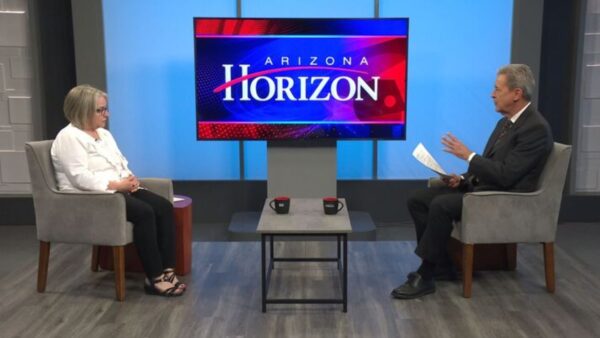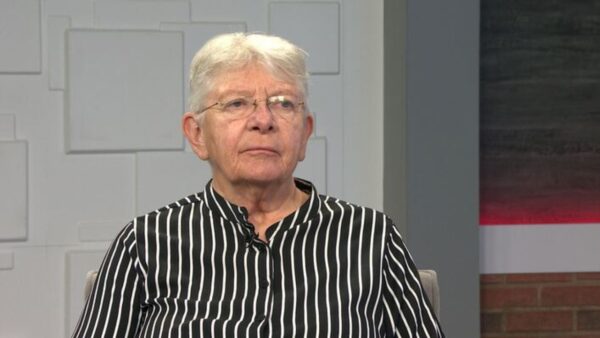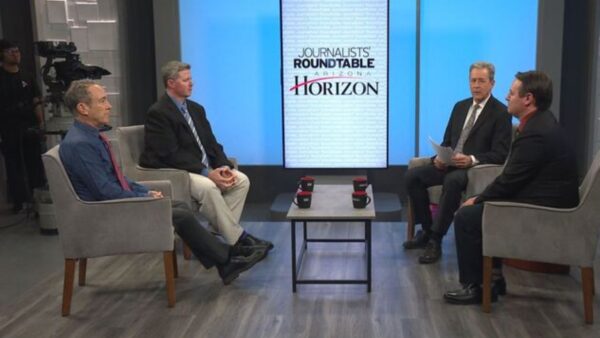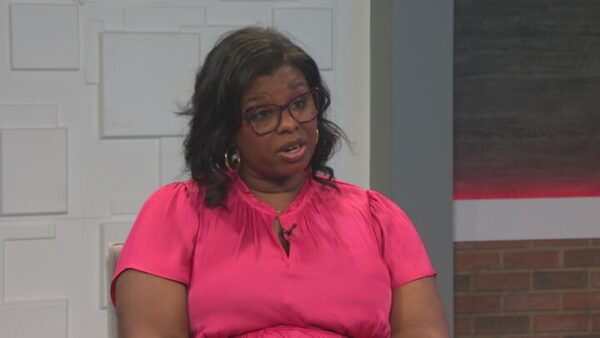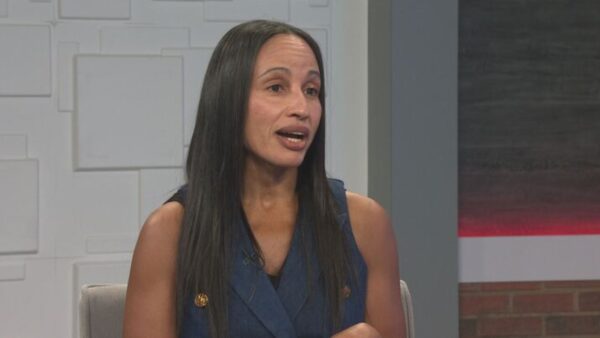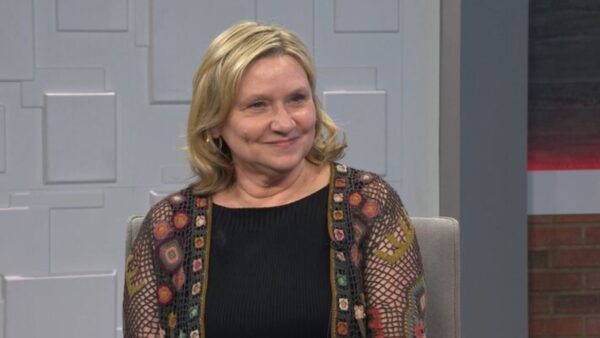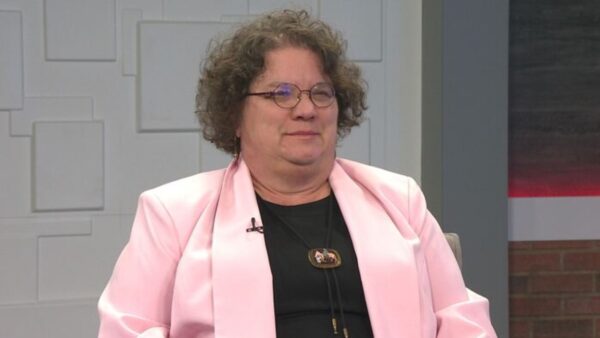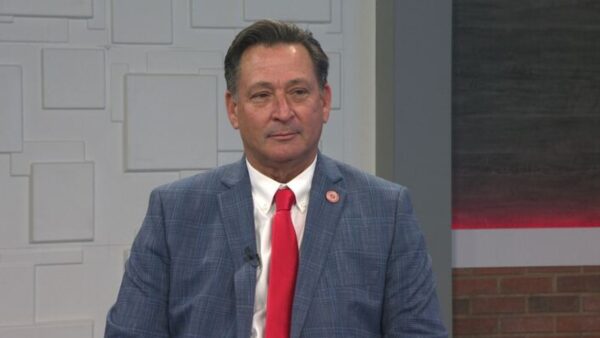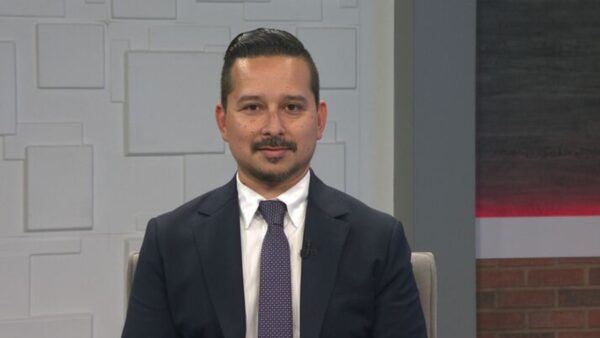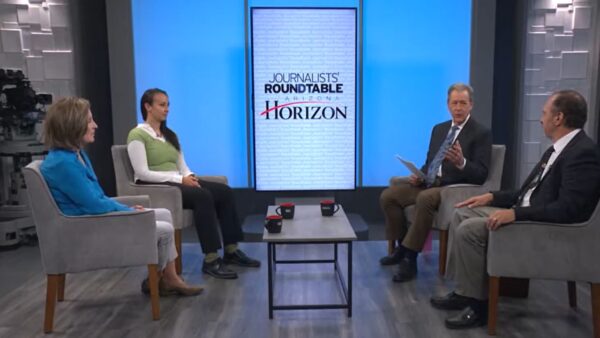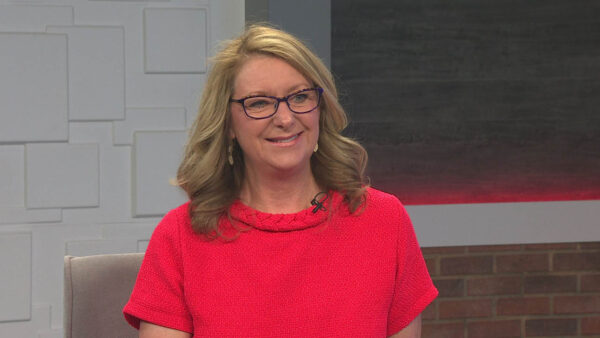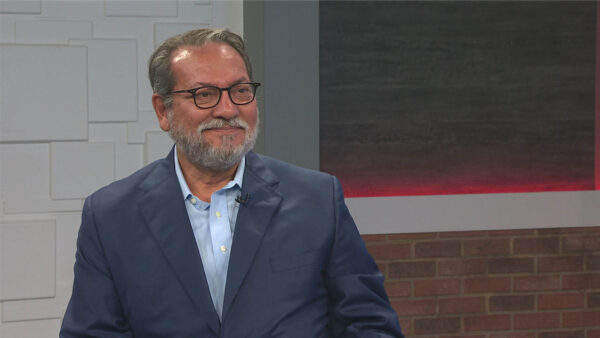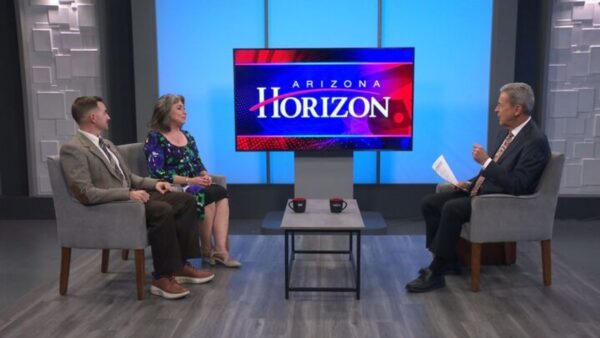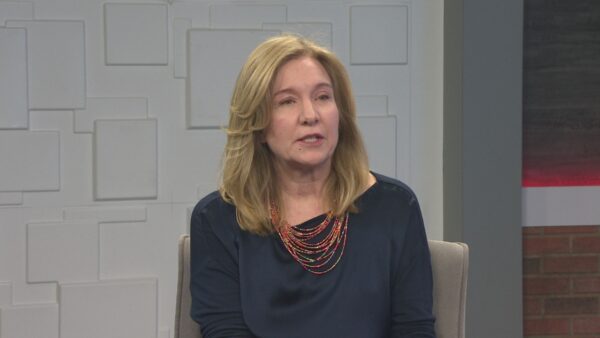Eleven chairs have been created by ASU Interior Design Students in an effort to bring awareness to domestic violence and kick off Domestic Violence Awareness month. The chairs make statements about domestic violence and will be auctioned at a dinner event benefiting the Phoenix Family Advocacy Center. PFAC Director Ginger Spencer joins the discussion.
>> Michael Grant
Tonight on "Horizon," a conversation with one of the preeminent investigative journalists of our time, Seymour Hersch. Plus, this art makes statements about domestic violence and will be auctioned to benefit crime victims, including domestic violence survivors. Those stories next on "Horizon."
>> Announcer
"Horizon" is made possible bye by the friends of channel 8, members who provide financial support to this Arizona PBS station. Thank you.
>> Michael Grant
Good evening, I'm Michael Grant. Welcome to "Horizon." The impact of revelations at Iraq's Abu Ghraib prison continues. Last week a federal judge ruled that more photos and videotapes made by guards at the prison be released to the public. The Pentagon is expected to appeal the ruling, arguing the release would encourage anti-American propaganda. Also, Private First Class Lynndie England, was convicted by a military jury of prisoner maltreatment last week. In an interview on NBC's date line, she claimed there were worse things that happened at the prison. She claimed military intelligence encouraged her and her colleagues to humiliate the prisoners. The investigative journalist who first exposed the conditions at the prison spoke at Gammage auditorium last week. Seymour Hersch gave the Jonathan and Maxine Marshall distinguished lecture. His latest book is "Chain of Command, the Road from 9/11 to Abu Ghraib". Larry Lemmons spoke with Hersch at the Tempe mission palms.
>> Larry Lemmons
At the time of the interview, Lyndie Dee England, she has been convicted. I don't know if she's been sentenced.
>> Seymour Hersh
She got three years yesterday.
>> Larry Lemmons
I read an interview with a general. She used to head Abu Ghraib. Who do you think is ultimately responsible for Abu Ghraib?
>> Seymour Hersh
Of course the people at Abu Ghraib, the kids who did what they did, the reservists, the untrained, frightened, not very sophisticated Lyndie Dee England, deeply in love with a guy and led her into it. Of course, they are responsible for their actions. We can't say otherwise. But the idea that a bunch of reservist from West Virginia would come to Iraq, get into a prison and understand that the way to humiliate an Arab is to sexually humiliate them. The Arab world works on shame. We work on guilt. They are forever your enemy. The idea that that would be a way to break down an Arab is just something -- if you are going to tell me that Linda England understood that. The idea of using sex and putting them in sexual positions, photographing them nude. In the Koran, men are not -- it says many times at least three times explicitly, men are not supposed to be seen frontally nude. There is also taboos against homosexual activity. This is all real traumas. There is no way these kids knew that. We now know anecdotally from everything that we read in the last year, particularly last year-and-a-half since Abu Ghraib, it's widespread this kind of abuse, sexual abuse. So where does it go? Did the president say I want this to happen? No, but here's the critical CRIT call thing, did anybody ever stop it at any point, and the answer is no. And it's in the chronology. You know, some reporters -- I like to start with chronology when I look at something. What happened in Abu Ghraib took place between September of 2003 and January of 2004 when somebody inside blew the whistle that began the investigation. Rumsfeld was told about it in early 2004. By the end of January, Rumsfeld testified to the congress, to the senate, that he had been briefed on it and the president had been preferred. By the end of January. So what happens next, '04? Four months later, I write a bunch of stories about that in the New Yorker. CBS produces some photographs and we go on. The president says I didn't know anything, I didn't authorize it. We can't write about what doesn't happen. It's what did the president do when he learned about it? Between the time he learned about it in late January of '04 and the time it became public four months later and the answer is NADA, nothing. Did bush say to rums field, what's going on here, wait a minute changes made, I want everybody brought up on charges, I want this investigated? Nothing happened. Where does responsibility lie? In this case, it's something even when I wrote the book I didn't realize. As a journalist you don't see what you can't -- those kind of timelines, you don't see right away. It didn't dawn on me that he knew about it and didn't do anything.
>> Larry Lemmons
Do you think the --
>> Seymour Hersh
- actually, that's an interesting question, because you are right and wrong. You are right about the trauma of 9/11 was profound. It was frightening, very scary to have people fly airplanes into buildings. We were angry. We wanted payback. And so the abuse began very early. If you remember, there was a guy name John Walker Lindh, the kid who was busted up family in California, and most kids when they act out they wreck the car and do too much dope. This kid joined the Taliban. He really was far out. But when he was captured, he was an American with the Taliban right after the Afghanistan war began. He was abused in front of us. They threw him into a holding pen. They let people hurl things at him. He had a bullet they didn't take out for five days. We saw it all and said yeah, right. There was a collective sense. This is what leadership is about. It was up to the leadership to say at the very beginning, even in the John Walker Lindh case, this is not tolerated. It didn't happen. In a funny way, it's almost understandable, but it's not America. We don't do that. And other thing, the reason we don't do this kind of mistreatment is any professional intelligence officer, military intelligence debriefer, prison interrogator will tell you that you don't get good stuff by pounding it out of people. You get -- if you are prepared to fly an airplane into a building and die, a broken finger? Come on, you have a story to say, you are going to say it under pressure. It's a lie. The good stuff comes from taking the time to get empathy with somebody, to show them the wrongness of their ways. We did this a lot in World War II. A lot of the great interrogators. Some of the Germans were terrific. They got information by being sympathetic, not by abuse.
>> Larry Lemmons
There were photographs that we never saw from Abu Ghraib.
>> Seymour Hersh
I see more stuff. At the New Yorker when I got a bunch of photographs, some horrible stuff, we thought enough is enough, and we weren't thinking about the editor, David Remnick. We were thinking this is enough for the Arab world, how much do you want to humiliate piece theme. They were photographs that the New Yorker ran about a man, a prisoner, naked standing there with two snarling dogs and he's got his hands behind his head. He's not even permitted to protect his private parts. He was bitten in a sense and bled very badly. All of those photographs, how much do you want to do?
>> Larry Lemmons
What would you say to the argument that showing those photos hurts the effort on the war in terror?
>> Seymour Hersh
Sure. Do you really think the Iraqis didn't know what we were doing to them? Everybody knew about Abu Ghraib. I knew about Abu Ghraib because I do a lot of reporting on Iraq since 9/11 for the "New Yorker." I learned about Abu Ghraib from a general in Christmas of '03. What he told me then, and at that time, what are you going to do? I'm talking about something else, he happened to mention it. What he told me, this general, he drove out from Iraq into Syria to do this. There is a lot of flow back and forth. There was then, less now. He said that it was so bad that there was a special section for women. The women prisoners were sending messages home through other people to their dads and brothers to come in the prison and kill me. Because I've been defiled. You know, GIs play grab ass. I wasn't raped, GIs go into a shower room with a camera and grab somebody. Dumb kids will do dumb things. Smart kids will do dumb things, too. You know, that's one of the things in this whole case with Lyndie Dee England and all of these GIs, enlisted people that have been put away, the nine in Abu Ghraib, we send our kids to war and there is nothing as vulnerable and as stupid as a 20-year-old with a weapon, and the officers are supposed to be what we call in local PARENTIS. The Marine Corps is strong on this. They emphasize, you are in charge of these 18 and 19-year-old kids in the war zone and you will keep them, not only protect them from bombs, you protect them from doing the dumb things. Where was that protection in that case? In the Lynde Dee England case.
>> Larry Lemmons
You covered the Vietnam War as well, the me lie massacre. How would you say the coverage of that war compares to the coverage of the war in Iraq? We have embedded journalists in Iraq. How is this different?
>> Seymour Hersh
You can't cover this year. I was in London recently. I was talking to a British journalist who has tremendous contacts. He knows air big. He said, look, mate, let me tell you, I'm not afraid to be in any combat zone as long as I can report, but you can't report in Iraq. You can't even go out. It's too dangerous. A Werner in a car, whether he's in a convoy or by himself, you simply can't make it anymore. They will get you. Robbers will grab you and want ransom or the insurgents will kill you. It's a civil war. Come on. Nobody wants to say it in America. It's a civil war. It's sectarian violence. 15 be headed here. All Sunnis, all Shiite? My God, what do you need to know?
>> Larry Lemmons
Following that line of thought, what do you think is the future of Iraq?
>> Seymour Hersh
I think it's going to be divided between north and south. I think the Shiite are going to take -- I think it's a perfect trifecta in reverse. In a horse race fan, you know what I mean. In the south, we're going to have the Shiite control, which means Iran has tremendous influence there. From the United States point of view, this new southern Iran -- Iraq, rather, will be much more hostile to Israel than Iraq was. In the old Sunni Heartland where Baghdad is, you are going to have Somalia, constant war, back and forth. We're going to destroy as much as we can, or the Iraqi army. And in the north you'll have Kurdistan. We believe that turkey will allow Kurdistan to exist. I will tell you right now, you rub a Turkish officer and you say what about Kurt Stan and he will say there is no Curtis Stan. They are not going to toll raid the Kurds grabbing that oil and declare themselves independent. It's not going to happen. So we could have a war. It's just a mess, and bush's plan is to get out. I applaud that, the faster the better, but it's not realistic. The goal right now is to -- they've got a constitution. The smart people in Washington are all saying, it should be defeated because it's a formula for civil war. It makes it almost official, because it declares Kurds to be separate. It declares the south to be separate. It means the Sunnis have nowhere to go but to keep on fighting and being insurgents. The goal is to -- they are having a referendum that they'll probably win. They'll have an election in December and some governments as useless as the governments we now have in Iraq are, and then we'll start pulling out. We'll say it's their problem. It's a far cry from what we promised. The president told us we were going to install democracy there. You don't hear that out of the Whitehouse. For that matter, when was the last time I saw Richard Pearl on television.
>> Larry Lemmons
Thank you very much, Mr. Hersch.
>> Seymour Hersh
No problem.
>> Michael Grant
October is domestic violence awareness month. It is an opportunity to note how prevalent the problem is here in our state. Some statistics from the Arizona Attorney General's Office, in 2004, there were 80 domestic violence-related homicides in Arizona. Nine of the victims were under 18 years old. 70% of all known domestic violence-related deaths in Arizona involve a firearm. And two out of every three women who seek shelter in our state will be turned away because of lack of space. As domestic violence shelters struggle for support, one local shelter is preparing for its annual fundraiser. It is the Phoenix annual "Chair-ity" dinner event. Some unique art will be auctioned to raise money. Merry Lucero has more.
>> Merry Lucero
Sharp edges, startling curves, rhythm. Ideas that ASU interior design students used to transform a mundane everyday object, a chair, into a statement about domestic violence. 22 students formed teams of 2, with less than 4 weeks and $100 limit each, 11 chairs were created. Materials, shape and structure played a part in the design of the chairs.
>> Andrea Brosman
We used CDX plywood for all of these legs slats, and we chose wedges because it's really natural and it's a humanistic form. We named our chair "interruptions." That's why we have the two metal pieces. They are basically interrupting what's going on with the wood, so you have your rhythm and then you have your interruption of metal.
>> Ryan Vink
We designed it as a chair for two, because it's like a silent conversation between the person being abused and the abuser. And the person being abused is the one that's sitting here, because they are more comfortable. And then the abuser is leaning against them because they have to -- an abuser has to abuse someone to support their own weight.
>> Merry Lucero
Students were to choose an artist for creative inspiration in the design.
>> Dala Al-Fuwaires
We chose Maya Angelo. We wanted to venture out from the typical art that you are used to an image or a painting and we wanted to do something poetic. Because we selected a poem there is lots of rhythm involved. There is rhythm this way and then there is rhythm with the stacking of the wood in this direction as well.
>> Ryan Vink
And the curves also are kind of to sigh Thai in with the abusive situation. There is ups and downs to that situation. Sometimes it's okay; sometimes it's really bad. That's why we kind of overemphasize the curves and create these concave curves, which made it more difficult to build.
>> Lauren Ledvina
We chose a ballet choreographer. We were allowed to go outside of the box with art. It is really contemporary and uses traditional ballet to set a backdrop. And then he throws in these modern movements. It creates contrast so that you understand what you are watching and it makes you very involved in his pieces. We thought that was a good strong concept that related to domestic abuse and a victim's life.
>> Merry Lucero
The students also listen to domestic violence survivors tell personal stories about their abuse.
>> Lauren Ledvina
We thought of someone's life having a rhythm to it, and. When she talked about her story, she kind of wanted to live this life that everyone else had and had a rhythm, and then she talked about when she was abused how it was so different from what she knew before, and how it just made that such a strong contrast in her life. She was kind of thrown off balance by abuse. And so that's probably one major aspect that we took into it.
>> Dala Al-Fuwaires
Well, the poem by Maya Angelo is about abuse, discrimination, which is some sort after abuse, regardless. And it was easily to relate her to the family advocacy center, because the poem talks about her ability to rise and to have the power to rise about these unfortunate circumstances. That's exactly what the family advocacy center tries to tell their victims to do.
>> Merry Lucero
Students were challenged to incorporate all of these elements into their chairs, making their designs and their lesson more powerful. The chairs will be auctioned at the City of Phoenix annual "Chair-ity" dinner in November. The proceeds will benefit the Phoenix family advocacy center.
>> Michael Grant
Joining me now to talk more about the "Chair-ity" event and domestic violence issues, Ginger Spencer, the director of the Phoenix Family Advocacy Shelter, and Danielle Cain, director of the Chrysalis Phoenix Shelter. Ginger, that's a cool event. You've been doing it for a few years, haven't you?
>> Ginger Spence
Yes, this is going to be our 6th annual event. This is the 4th year that we're partnering with Arizona State University with the students from the school of interior design. The "Chair-ity" event is uniquely spelled c-h-a-i-r-i-t-y like a chair you on. This is our fund raising event we do for the family advocacy center. The advocacy center is a one-stop shop for victims of domestic violence and sexual abuse, and every dollar that is raised from the "Chair-ity" event goes directly to providing client services.
>> Michael Grant
The four students that we saw, they were the winners for the competition and they get scholarship money?
>> Ginger Spence
Yes, they do. We have a group of professionals from the international interior design association that come out and they analyze the chairs, and they grade them and then they pick a winning team. Actually this year for the first time, we had two winners, and so the top team will get a scholarship for $500 and the second team will get a scholarship for $250. That'll help the students out with some books. They put a lot of work into these chairs. They have a very limited budget. They can only use $100. And they do it within a very short time frame and it's just wonderful to see the artwork they are able to create and then tying that into domestic violence as well as just to help raise awareness about the family advocacy center.
>> Michael Grant
I admire that kind of creativity. I can come up with a folding chair, but nothing too exciting. Danielle, tell us about Chrysalis.
>> Danielle Cain
We've within in the valley for 20 years now. We have a Scottsdale in Phoenix and one in Scottsdale. We have outpatient offices for outpatient counseling as well as a transitional housing program that has apartments all over the metropolitan area.
>> Michael Grant
Housing and shelters are in short supply, period, as I mentioned earlier on. But I know one of the problems also is that there is from time to time been bed space, but not a whole lot of transitional space?
>> Danielle Cain
Right. Transitional -- by the time women get to transitional housing, it's a wonderful point in their recovery, because they are ready to make the change, you know, they've already been through the cry circumstances and they are ready to have, you know, a life-long change. Therefore, by the time they get to transitional housing, they tend to stay. They tend to finish the program. That's up to two years in our program. So therefore, there is not many opening very often.
>> Michael Grant
Begin gentlemen, the family advocacy center, you touched a little bit on it, but fill us in on a few more details on what the advocacy center does and what it does and what it is.
>> Ginger Spence
We use a multidisciplinary approach to help victims of domestic violence and sexual abuse. Some of the service that is we provide at the center week, do provide counseling services. We have support groups. We have a support group just about every day of the week. One of our support groups, actually two of them now are in support with chrysalis shelter. But we're able to provide financial assistance. We're able to do orders of protection right on site at the center. We offer a wide range of services. We've relocated individuals to other cities and other stats to get them into a safe place, and we help them get placed into shelter. If shelter is not available, as you heard the statistic earlier, for every woman we are able to place, two are turned away. When that is not available, we can help put them in a hotel or motel until bed space becomes available at one of the valley shelters. So, we offer a wide array of services and all of our services are free of charge because of the fund raising that we do through the "Chair-ity" event.
>> Michael Grant
Danielle, resist the temptation to say "both" because I think it would be an accurate answer, but in terms of funding, is the funding the biggest funding gap for a shelter or is it for prevention programs?
>> Danielle Cain
Well, I would have to say shelter only because like Ginger said, it's almost 80% of women that are looking for shelter are turned away. You know, we're in competition with other things that are happening in the world, not just domestic violence issues, but you know, hurricane Katrina, or whatever happens to be going on right now. So funds tend to be short because of that. So, we're looking -- also, let me say, another thing that I find personally, the shelters that people want to donate during the holidays and kind of forget about you during the summer.
>> Michael Grant
Sure, that happens with a lot of charities.
>> Danielle Cain
Absolutely. So I think one of the things that would help us, the greatest, is to get funders that would donate to us year round and to the cause of domestic violence year round, even if it's not to chrysalis, but the family advocacy center or anywhere.
>> Michael Grant
Ginger mentioned coordinated programs between the two
>> Danielle Cain
Absolutely. Like Ginger said, we're now doing two groups. We're getting ready to start our second group at the family advocacy center, which is a children's group. We're incredibly excited to be a part of that. Our adult survivor group has been successful there. They also use us. They call us up; see if we have any beds, if we can work anything out to get someone into shelter, even if we have to couch them for the night. We do what we can do to get someone help.
>> Ginger Spence
One of the things you had mentioned was prevention. That's why this children's support group is so important, because we're able to provide services and help children who have witnessed domestic violence in the home. The children are forgotten about. And they truly are secondary victims. And so what with our partnership with chrysalis, we're able to provide a support group for the children, ages 6 through 12, who have witnessed domestic violence in the home. That way, we can work with the children to help them develop their own safety plan and help them to know that this is not how you show love. This is not a healthy relationship, so that when they become adults, they don't become abusers or victims themselves.
>> Michael Grant
The profile of domestic violence has elevated over -- I'll take a shot and say the past decade, I guess. Has that helped? People being more aware of the problem and situation?
>> Ginger Spence
Yes, we definitely want people to be aware of what domestic violence is, so there is a whole lot of education in that area. And then we want them to be aware of all of the services that are available to help them. So, you know, this family advocacy center has been opened for six years, and each year, the number of people that we help, it increases. Now, someone may say does that people domestic violence is on the rise? Well, I can't answer that, but what I can say is we actually want our numbers to increase because we know that domestic violence is occurring, and that actually shows that more people are aware of what it is, and that they are comfortable with reaching out for help.
>> Danielle Cain
Right. And we still have women today that come to the shelter and say, you know, until yesterday, I've never heard of a shelter. Believe it or not, they are still learning about shelters.
>> Michael Grant
Danielle Cain, thank you very much from chrysalis, for joining us. Ginger Spencer, thanks for sharing the information. Cool event, "Chair-ity." Speaking of which, charity dinner is on November 17th at the Phoenix Art Museum. Call the Phoenix family advocacy center at area code 602-534-3072. And on Thursday, October 20th, channel 8 will air a powerful new one-hour documentary that chronicles the impact of domestic violence on children "breaking the silence, children's stories." You'll find that October 20th at 10 p.m. For transcripts of "Horizon," links related to tonight's topics and upcoming program information, visit the web site at www.azpbs.org.
>> Announcement
The United States Supreme Court membership had been holding steady for the past decade, but this session, the court will have two new faces. Paul Bender and Kathy O'Grady will talk about the new Justices and how they might impact the court. They will discuss the bigger cases the court may handle this session. That's Wednesday at 7:00 on "Horizon."
>> Michael Grant
And on Thursday, Governor Napolitano will join us for her monthly visit. You can send in a question for the Governor via E-mail to [email protected]. Your question may be used on the air. Then, of course, on Friday, we'll have the Journalists' Roundtable and the weeks' wrap-up of news events. Thank you for joining us on this Tuesday evening. I'm Michael Grant. Have a great one. Good night.
Ginger Spencer:director of the Phoenix Family Advocacy Shelter;Danielle Cain:director of the Chrysalis Phoenix Shelter;






